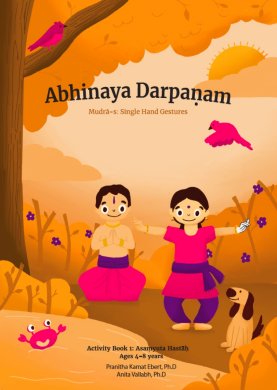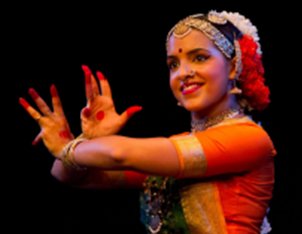
|   |

|   |
Abhinaya Darpanam: Mudra-s: single hand gestures - Sharmila Rao e-mail: contact@sharmilarao.ch April 5, 2022  SERIES: Abhinaya Darpanam TITLE: Mudra-s: single hand gestures LANGUAGE: English AUTHOR: Dr. Pranitha J Kamat (kamat.pranitha@gmail.com), Dr. Anita Vallabh YEAR: 2021 PAGES: 66 PUBLISHER: Vedathek Publishing House, Bangalore, India ISBN: 978- 81-9535-732-1 This review is for the book titled 'Mudra-s: Single Hand Gestures' from the 'Abhinaya Darpanam' series by Natya Chittra. "Mudra-s: Single Hand Gestures" is a children's book that introduces children to Indian dance gestures. The basis for this activity book was Anita Vallabh's 'Message in movements: Abhinaya Darpanam, an illustrated translation.' The author Dr. Pranitha Kamat wants to stimulate children's creativity with the coloring pages and illustrations of the meaning of each gesture. It is important to her that children can discover and understand the book independently, without having to rely on instructions from adults or a dance teacher. The hand gestures are mentioned in their traditional order. On each double page one hand gesture is presented. The meaning of the gesture name is explained on the left side. On the right, the meanings that the same gesture can have in storytelling are illustrated. Each gesture can be used for different meanings in dance. In order to specifically draw the child's attention to these different meanings, these elements are blank in the illustration. The child should color these and thereby learn how to use the gesture. At the bottom of the page these meanings are also mentioned in words. To the end of the book, the author has included blank pages for the children to write their own stories. Attached to the book is a poster with an overview of all 26 individual hand gestures. The book has a clear and concise concept. The wish to educate and engage children is visible: the large hand silhouettes and clear shapes in the illustrations encourage children to color. The book has a good size and the paper is of good quality, which is very important especially for coloring books. Using the book in my dance classes with children has been a very positive experience. My dance students were particularly enthusiastic about the poster. The smaller children were immediately encouraged to try out every hand gesture. The slightly older children were more occupied with the names and tested how many of them they already knew by heart. For dance students, the book is a great way to get in touch with dance in a creative way other than through training. I have also given the book to children who have no relation to Indian dance. They are particularly fascinated by telling stories with their hands, and they try out their own versions of hand gestures. Despite the many merits of this activity book, it has two challenges. The book is aimed at children between the ages of 4 and 8. However, it's precisely in this interval that children develop enormously. While 4-year-olds can hardly read, 8-year-olds sometimes feel bored with coloring books. Even Dr. Kamat cannot completely escape from this dilemma. Despite the great drawings, the explanations are still very closely connected to the written word, because some illustrations can only be understood with the help of the comments at the end of the page. Children in particular who cannot read yet (or who do not speak English) need the help of an adult here. Dr. Kamat therefore doesn't quite achieve the claim of a book for children, for which no additional guidance is required. According to the author, the empty pages at the end of the book should encourage kids to invent stories. In doing so, however, Dr. Kamat contradicts the general concept of storytelling through dance and gestures, which unfolds detached from the written word. It would have made more sense here to provide examples of stories with keywords, with which the children can both test their knowledge of hand gestures and have a template for how to put together stories with hand gestures. There is hardly any other topic in Indian dance that has as much literature as there is about hand gestures. With such an abundance of literature, it is not at all easy to find a new meaningful approach. But Dr. Kamat succeeded in this. In her children's book, she shows in a simple but lasting way that hand gestures are more than their name and shape. Through the illustrations with different meanings, she draws attention to the fact that there are no limits to the expression of gestures. Children in particular are happy to accept such indications and continue to experiment. Dance thrives on this creativity. This book is therefore an excellent supplement to dance lessons for children.  Dr. Sharmila Rao, born in Switzerland, grew up in a half-Swiss, half-Indian artist family. She has been on stage since she was 12 and giving dance lessons since she was 18. Teaching Bharatanatyam especially to young people who are growing up in two cultures like her has become her passion ever since. Sharmila has an MA in Indian Studies and PhD on Padas of Purandara Dasa. She currently runs her own dance school in Zurich, Switzerland. Post your comment Please provide your name and email id when you use the Anonymous / blog profile to post a comment. All appropriate comments posted in the blog will also be featured in the site. |